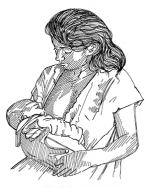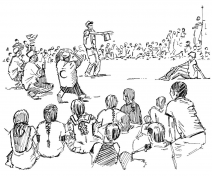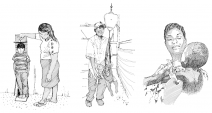14. Infant and young child feeding in emergencies
Overview
In emergencies, pregnant and breastfeeding mothers, and infants and young children (from birth to two years) may require special nutritional/feeding support. Breastfeeding and complementary feeding with appropriate first foods help to save lives.
Breastfeeding
- Breast milk is a clean, nutritious and free-of-charge food. It also helps babies to fight off infections and disease (see Action Tool Breastfeeding). It is the safest choice in emergencies when people may lack access to safe water and hygiene, a regular supply of food, income or a livelihood.
- Breastfeeding helps fight disease. In most circumstances, a mother should continue to breastfeed when she or her child is unwell. Stressed, malnourished, ill and hungry mothers can still make enough milk to feed their babies. If milk flow stops, it may be possible to restart it with support and counselling. Other options may also be available, such as milk banks if they are available. It is vital to encourage and support mothers, as well as other caregivers and the extended family, to ensure breastfeeding can continue during emergencies.
- In some cases, breastfeeding may not be possible, or families may choose to use Breast Milk Substitutes (BMS). In these circumstances, it is important that they have the knowledge and tools on how to safely prepare and store BMS and how to maintain appropriate hygiene and cleanliness to decrease the chance of the baby becoming sick.
- Use of BMS/formula and bottle-feeding can increase the incidence of diarrhoea and even death when bottles/teats are not adequately cleaned or sterilized, or the water used is dirty. Furthermore, it is important to be aware that sometimes for-profit companies aggressively advertise baby formula as equivalent or superior to breast milk. This is not true and there is scientific evidence that shows breast milk is unique and has many benefits that cannot be replicated by artificial products.
Complementary feeding
Complementary feeding should start from six months of age to “complement” (to be given with) breastfeeding. First foods are those we give to babies between the ages of six months to two years. These foods should be:
- Accessible (should be easy to find, inexpensive and easy to prepare)
- Healthy and nutritious (high in vitamins and minerals)
- Safe and easy for babies and young children (easy to hold, easy to chew, easy to swallow)
Complementary foods to avoid are those that are highly processed (many packaged, pre-prepared foods are highly processed) or chemically prepared, and that contain high amounts of sugar and salt. Natural foods (without added salt, sugar or chemicals) are often best.
Difference between complementary, supplementary and therapeutic feeding
Complementary feeding (formerly called “weaning”) refers to foods that are given to breastfed infants and young children, in addition to the breast milk they receive. Sometimes, it is confused with supplementary feeding, but these two things are not the same. Examples of complementary feeding are giving babies cereal or mushed vegetables in addition to breast milk.
Supplementary feeding means providing extra food to individuals or families, beyond what they would normally have. This is usually done to prevent undernutrition. Examples of supplementary feeding are provision of extra bags of rice to a household or providing food vouchers to families.
Therapeutic feeding refers to using specially designed, ready-to-use, nutrient-rich foods to treat malnutrition. Therapeutic feeding is a medical treatment and must be done and monitored by trained health care providers as part of malnutrition treatment programming. An example of therapeutic food is PlumpyNut.
What do to and how to do it
General support
- Find support within the community
- Find out the location of breastfeeding tents, caregiver support groups, mothers’ groups and other services that can help support families and carers who are feeding infants and young children.
- Include fathers, carers and other family members in discussions (where culturally appropriate) to ensure that mothers are supported when they breastfeed.
- Make sure that mothers, carers, fathers, support groups and communities receive correct information on infant and young child feeding (IYCF).
- Provide or promote nutritional support and supplementation during and after pregnancy
- Increase the number of meals or snacks during pregnancy (one extra) and breastfeeding (two extra) to make sure mothers have enough nutrients and energy.
- Encourage consumption of locally available nutritious foods, including foods rich in iron, calcium and vitamin A.
- Encourage mothers to take the advice of healthcare providers in relation to vitamin and mineral supplements to be taken during and after pregnancy. For example, women should be encouraged to follow health guidance about:
- Taking iron/folate supplements during pregnancy and for at least three months after giving birth (the dose should be determined by a healthcare provider)
- Taking Vitamin A supplements within six weeks after giving birth (the dose should be determined by a healthcare provider)
- Provide or promote prenatal support during pregnancy
- To prevent infections, mothers should follow the advice of healthcare providers. For example:
- Getting anti-tetanus immunization(s) before or during pregnancy
- Taking deworming and anti-malarial medicines during pregnancy (the medications and dose should be determined by a healthcare provider)
- Using insecticide-treated mosquito nets
- Preventing and treating sexually transmitted infections (STIs) (the treatment should be determined by a healthcare provider)
- Encourage recommended hygiene practices, including:
- Handwashing with soap
- Good food hygiene
- Safe sanitation
- Safe drinking water consumption
- Encourage families to support and assist women with their workload, especially late in pregnancy.
- Encourage families to allow mothers to rest more.
- To prevent infections, mothers should follow the advice of healthcare providers. For example:
- Breastfeeding support
- Encourage mothers to breastfeed, even if they are stressed, ill or hungry.
- Refer mothers who are malnourished, overtired, worried they lack milk, unwell or in low spirits to a health facility or feeding centre for nutrition and psychosocial support, including education on IYCF.
- Respect their choices.
- If breastfeeding is not possible or not recommended, support families with knowledge of how to safely prepare BMS (using clean/sterilised water and preparing according to manufacturer’s instructions), where to access clean water, how to ensure cleanliness of cups and spoons, how to store formula safely, etc.
- Promote methods of sustaining or increasing milk supply:
- Help mothers to find a safe and quiet place to relax since this helps milk flow.
- Encourage mothers to give breast feeds frequently (day and night, at least eight times each day for children less than six months old)
- Encourage skin-to-skin contact between mother and baby (which can help increase milk supply
- Encourage mothers to breastfeed, even if they are stressed, ill or hungry.
- Complementary feeding support
- Encourage families to give their infants small and frequent meals.
- Make sure families know how to clean, store and prepare food safely.
- Encourage families to drink clean water and adopt recommended hygiene practices:
- Including washing hands before food preparation and feeding
- Work with National Society colleagues (or other organizations) who specialize in water and sanitation (WASH), health and other relevant sectors to ensure that clean water and sanitation are available.
- Encourage families to provide nutritious complementary foods, including:
- Foods rich in iron (meat, chicken, fish, green vegetables, beans, peas)
- Foods rich in vitamin A (organic meats, carrots, pumpkins, papayas, mangoes, eggs)
- As well as a variety of fruits, vegetables and fortified cereals.
- Promote appropriately textured first foods for young children that are easy to chew and to swallow (such as purées, mashed and finger foods)
- Encourage home-prepared and locally available foods. Some pre-packaged complementary foods for young children and infants can contain high levels of salt, sugar or fats, which contribute to obesity and noncommunicable diseases.
- Aid in monitoring the local food supply
- Report any donations or distributions of Breast Milk Substitutes, powdered cows’ milk, bottles or teats to your focal point in the National Society or Ministry of Health, or to the cluster or another authority responsible for monitoring violations of the WHO Code on Breast Milk Substitutes.
- Find out what local or distributed high energy foods are available for young children older than six months to complement the breast milk they receive.


